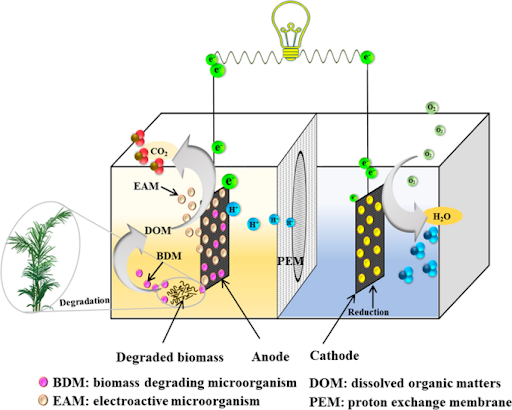
Microbial Fuel Cells (MFCs) have emerged as a promising solution in addressing issues such as organic waste management and clean energy generation. As both natural processes and industrial activities have contributed to a significant accumulation of waste, microbial fuel cells aim to generate electricity by using bacteria that break down organic waste. Typically, bacteria break down organic matter and produce electrons which are then transferred to oxygen molecules, gaining energy themselves. In the case of Microbial Fuel Cells, microbes are grown on an electrode (electrical conductor) that is oxygen free, transferring electrons and hence generating an electric current [1].
The term “Microbial Fuel Cell” can be traced back to the influential work of Bruce Logan at Pennsylvania State University who demonstrated the ability of certain microorganisms to create electricity by breaking down organic matter [2]. Because of their ability to generate an electric current, microbial fuel cells have many applications such as desalination (removing salt from seawater) and hydrogen production through electrolysis [4]. Despite extensive research, many areas of research still lack sufficiency: this includes low power density compared to other energy sources, limited microbial diversity, and costs of scaling up. With continued research and greater implementation, MFCs ultimately will aid in addressing multiple environmental challenges such as mitigating pollution while simultaneously generating clean, renewable energy.
With a greater need for eliminating organic waste and clean energy, microbial fuel cells have become an expanding market. Many large corporations such as Pepsi, scientists, the U.S. Environmental Protection Agency, the U.S. Department of Energy, and the U.S. navy have all contributed to the economic impact of MFCs. Microbial Fuel Cells’ ability to clean manufacturing wastewater has led to companies aiding in its economic impact [7]. With the aid of a government grant, the Australian beer company, Fosters, heavily influenced the technology’s development, as it created its largest scaled model -almost 250 times bigger than the original university prototypes [10]. Similarly, private company Aquacycl, has embraced MFC technology and expanded it to other companies -having MFC technology for wastewater for Pepsi, Vopak, and more [11]. Moreover, The United States Navy has greatly considered utilizing microbial fuel cells for powering environmental sensors, monitoring the quality of the environment. Due to variable conditions underseas (salt concentrations, temperature fluctuations, etc.) there have been many challenges to transitional power generators. However, The Naval Research Laboratory has shown that MFCs not only can use salt and heat tolerant microorganisms that thrive in these conditions, this energy source is conveniently wire free [6]. The economic benefits from these innovators are rampant as shown by the reduction of organic contaminants, contributing to an improved environmental equality.
Throughout the United States, and other countries, the acquisition of Microbial Fuel Cells have brought significant benefits into daily life by aiding in cleaner alternatives to energy, and reduced contamination in soil and water. An ethical concern of this technology is the use of genetically modified microorganisms for the fuel cells – having to alter factors such as electron transfer for optimal voltage production. As with many genetically modified organisms, there is great concern for exposure dangers such as cancer and allergens [8]. Federal regulations such as the Food and Drug Administration and the Environmental Protection must provide proper protections and mitigate dangers. Additionally, legal issues of Microbial Fuel Cell usage have risen, particularly within the context of disposal. These fuel cell’s components, including microbial cultures and electrodes, must have proper disposal regulations in order to ensure public safety [2]. Moreover, microbial fuel cell residual biomass, the original organic material after the MFC process, raises questions regarding disposal as well. Finally, social issues around this type of fuel cell include visual impact and cost efficiency. Public outreach and stakeholder engagement are essential to the adoption of MFC technology; however, a great limitation is the costliness of testing technology for commercial companies. Research groups in California report that “the cost to trial” could be “over $1500/microbial fuel cell” [11]. Moreover, the placement of these fuel cells in infrastructure may raise doubts from residents. Greater agency measures such as grants to fund testing and extensive feedback from residents will all aid in the acceptance of microbial fuel cells into social life.
Despite these challenges, the potential benefits of MFC technology for environmental sustainability cannot be overlooked and must greatly considered when working to continue advancing this technology.
[2] https://www.ncbi.nlm.nih.gov/pmc/articles/PMC8088421/
[3] https://pubmed.ncbi.nlm.nih.gov/17049240/
[4] https://illumin.usc.edu/microbial-fuel-cells-generating-power-from-waste/
[5] https://medium.com/techscope/microbial-fuell-cells-475febe208c6
[6] https://apps.dtic.mil/sti/tr/pdf/ADA594746.pdf
[7] https://www.nytimes.com/2007/05/02/business/worldbusiness/02iht-beer.1.5529489.html
[8] https://www.ncbi.nlm.nih.gov/pmc/articles/PMC10223362/
[10] https://www.cbc.ca/news/science/australia-taps-beer-waste-to-power-fuel-cells-1.687791
